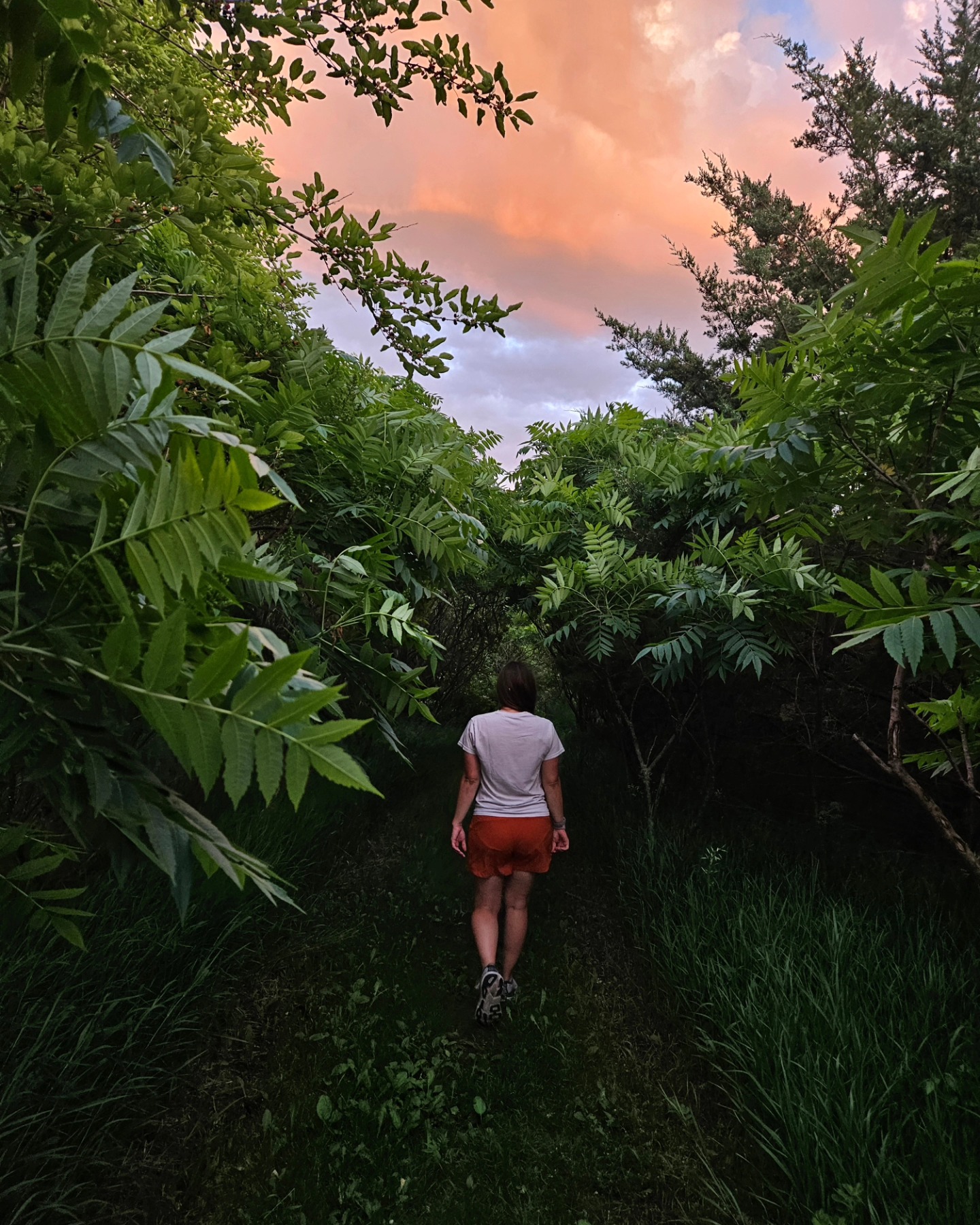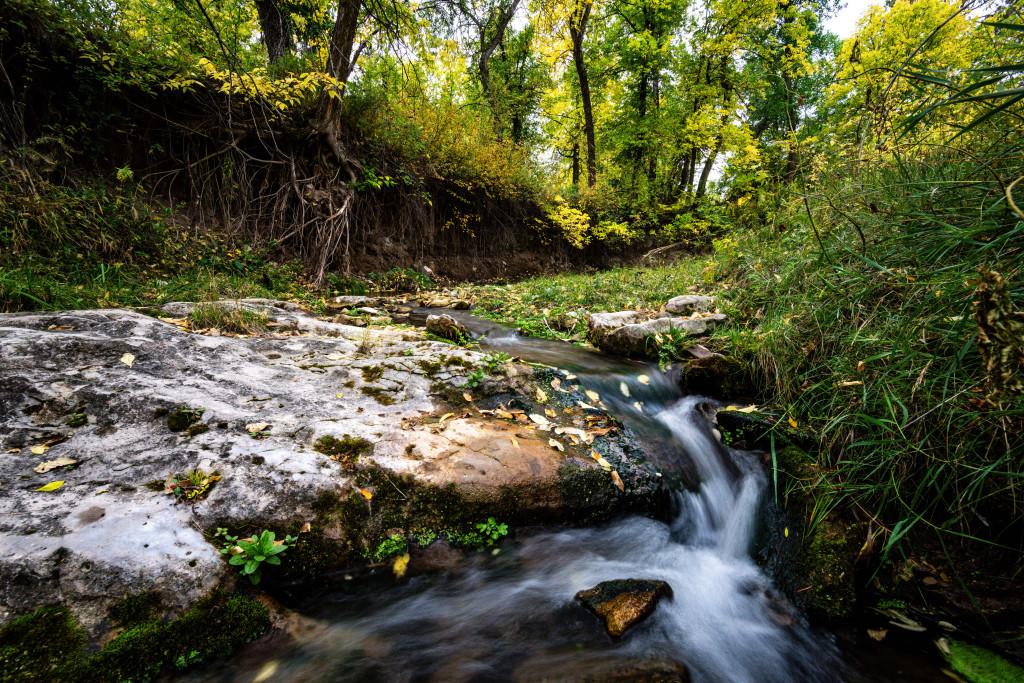
By Monica Macoubrie, Wildlife Education Specialist
In our fast-paced, tech-driven lives, finding tranquility can feel challenging. Forest bathing, also known as “Shinrin-yoku” in Japan, offers a restorative escape into nature, allowing us to reconnect with the natural world and recharge our minds and bodies. Forest bathing doesn’t involve exercise or hiking—it’s a meditative walk focused on engaging all the senses and immersing in the forest’s calming atmosphere.
Origins and Philosophy
Forest bathing was developed in Japan during the 1980s as part of a national health program. It’s rooted in the belief that humans benefit physically and mentally from being close to nature. As a practice, it emphasizes quiet contemplation, observation and deep connection to the environment. The goal is simple: Walk slowly, breathe deeply and immerse yourself in the sensory experience of the forest.
Unlike hiking, which typically involves a destination or specific fitness goals, forest bathing is not about reaching a point or burning calories. It’s about being present, relaxing and absorbing the forest’s atmosphere. It’s less about “doing” and more about “being.”
Benefits of Forest Bathing
Research highlights numerous health benefits associated with spending time in nature:
1. Stress Reduction – Studies show that time in nature reduces cortisol levels, lowering stress and promoting relaxation.
2. Improved Mood – Forest bathing can lift your mood and decrease symptoms of anxiety, depression and anger by enhancing serotonin production and dopamine balance.
3. Enhanced Focus and Creativity – A break in nature can restore focus and improve cognitive functions, often sparking new ideas and creativity.
4. Strengthened Immune System – Trees release phytoncides, organic compounds that have been shown to boost immunity by increasing natural killer (NK) cells, which help fight illness and infection.
5. Heart Health – Spending time in green spaces can lower blood pressure, heart rate and overall cardiovascular risk.
6. Better Sleep – Reduced stress and enhanced mental clarity can improve sleep quality.

How to Forest Bathe
Ready to experience the benefits of forest bathing? Follow these steps to get started.
1. Choose the Right Spot – Select a natural area where you feel safe and relaxed. A forested trail, botanical garden or quiet park can all work well. Ideally, choose a place with plenty of trees to experience the full effect of phytoncides in the air.
2. Disconnect from Technology – Leave behind any devices that might distract you, such as phones or headphones. The goal is to disconnect from screens and notifications to focus fully on the sights, sounds and smells around you.
3. Slow Down – Start by standing still and taking a few deep breaths. Tune into your surroundings, notice your breath and become mindful of how your body feels. When you begin walking, move slowly, taking each step with purpose and ease.
4. Engage All Your Senses
- Sight – Observe the different shades of green, the way sunlight filters through leaves and the various textures of bark and foliage.
- Sound – Listen to the rustle of leaves, chirping of birds or distant trickle of water. Nature sounds are known to reduce the brain’s fight-or-flight response, promoting calmness.
- Touch – Feel the textures around you—tree bark, cool stones or soft moss. Experiencing nature through touch is grounding and can create a sense of connection.
- Smell – Breathe in deeply and notice the earthy, woody scents of the forest. Phytoncides released by trees can reduce stress and improve immune function.
- Taste – If you’re in a safe area, consider tasting edible wild plants (consult a guide first if you’re new to this). Or bring a thermos of tea to enjoy, allowing the warmth to add to the sensory experience.
5. Be Present – If you notice your mind wandering, gently bring your attention back to your surroundings. This process is a form of mindfulness, allowing you to stay present without judgment or distraction.
6. Find a Spot to Sit and Reflect – Take a break, sit comfortably and simply observe your environment. Let your mind wander in a relaxed state, observing without a need to think or solve anything. Take note of how your body and mind feel—many people experience a sense of calm and clarity after a few minutes.
7. Conclude with Gratitude – At the end of your session, take a moment to express gratitude for the experience and the natural beauty around you. This simple act of appreciation can reinforce the positive emotions associated with forest bathing and foster a greater connection to nature.

Tips for a Successful Forest Bathing Experience
- Go solo or with like-minded company. Forest bathing can be most impactful alone or with individuals who share your intention of peaceful immersion.
- Don’t let weather hold you back—forest bathing can be enjoyed in various weather conditions, each offering unique sensory experiences, like the smell of rain or the warmth of sunlight.
- While one session can be beneficial, consistency maximizes forest bathing’s long-term effects. Aim for weekly or bi-weekly sessions if possible.
- The experience is about moving at a comfortable pace. Allow yourself to go slow and savor each moment.

Beyond the Forest – Bringing Forest Bathing Benefits into Daily Life
While it’s most effective in a natural setting, you can practice “forest bathing” principles at home or in urban areas by incorporating plants, taking mindful walks in city parks or listening to nature sounds. Creating mini “forest” moments throughout the day can help you retain the benefits of forest bathing even if you can’t visit a forest regularly.
Forest bathing provides a gentle yet powerful way to escape daily stress and reconnect with nature, offering mental and physical benefits that are increasingly important in our busy lives. Embrace the peace, take a deep breath, and let the forest guide you back to a place of calm and clarity.
